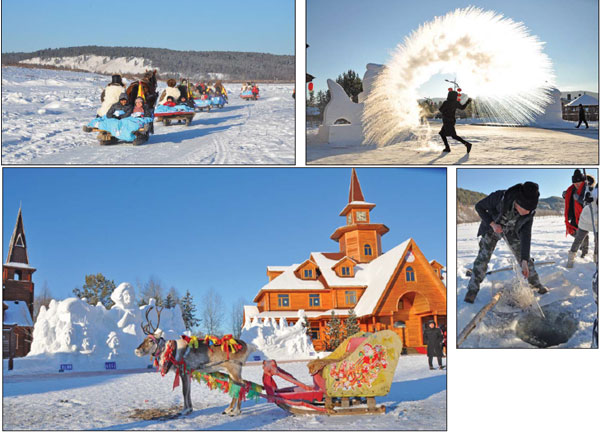The land of cold and gold

China's northernmost territory is a true winter wonderland for tourists
It takes courage to explore Mohe in winter - and some warm clothes.
Very warm clothes. A lot of them.
Temperatures in China's northernmost county plummet to a biting -40 C at night.
| Clockwise from top left: Tourists aboard one-horse sleighs in Santa Village in China's northernmost county of Mohe, Heilongjiang province; a visitor plays a popular game of splashing hot water, which freezes instantly in the cold air; villagers hack a hole in the river and push a net down for fish; a reindeer-drawn sleigh in front of the Santa's house. Liu Xiangrui / China Daily |
Days aren't much warmer.
But its icy climate is exactly what gives the small border settlement in Heilongjiang province its appeal.
At least much of it.
China is said to be shaped like a rooster. Mohe perches on the crest that prods Russia's belly.
Such offerings as the northern lights have elevated its position on the tourism map.
I recently visited the county and spent a few relaxing - and freezing - days in Beiji village, the country's northernmost community.
It was worth enduring the cold to experience Mohe's magic.
I'd prepared fretfully.
I borrowed thick shoes and other winterwear from friends. But I realized I had to buy even warmer footwear upon arrival.
Still, my feet froze.
Nonetheless, I was excited, as were the other tourists in our group from the southern province of Guangdong.
We spent the first night in the county town, where illuminated ice and snow sculptures lined the streets.
We headed to Beiji the next day.
About two decades ago, it was a poor hamlet. Today, it's a national 5A tourist attraction, the highest level.
We climbed a lookout tower halfway to the village and saw a river snaking through woodlands of rime-sheathed trees.
Then we enjoyed a stroll along a boardwalk through birch forests.
The village is situated on the southern bank of the Heilongjiang River, which marks the border with Russia.
Travelers come to visit China's northernmost post office, bank and primary school.
But its biggest single attraction is the aurora borealis. It's said to be the only place in China where the electromagnetic phenomenon can be seen.
Hundreds of photographers flock to the destination every summer in hope of capturing the northern lights - although sightings are rare in the warmer months.
I enjoyed it most when the village went silent after 10 pm.
We used phone apps to detect constellations among the countless stars.
We were able to snap a couple of satisfying photos of the Milky Way after standing outdoors for nearly two hours.
Despite the late night, we got up around 6 am to enjoy seeing the sunrise from a an observation tower.
Morning light sparkled on the rime-encrusted woodland. Haze drifted through the valley. Chimney smoke coiled from dwellings on the river's Russian side.
Such scenery is best explored aboard a one-horse open sleigh (jingle bells not included).
The village has a team of drivers, and passengers ride under quilts in the vehicles.
We watched them whoosh by on our way to go ice fishing.
Villagers hack holes in the river and use a long pole to push a net down. A day or two later, they return to collect their catch.
The fish are said to be particularly tasty but hauls depend on luck.
Afterward, we headed to the nearby Santa Village.
It happened to be a few days before Christmas and it was looking a lot like it everywhere we went.
Here, St. Nick's job isn't making a list, checking it twice and finding out who's naughty or nice. It's posing for photos with tourists.
Spoiler alert: As Mohe isn't really the North Pole, Santa isn't really Kriss Kringle but rather a Finnish native who plays the part.
Mostly, his job is posing for photos with guests.
Speaking of poles, we did see a pole-dancing party in front of Santa's house.
An unlikely venue, perhaps.
But seasonal performances are staged in which dancers dazzle crowds for up to five minutes outdoors with nothing but bikinis to shield them from the cold.
Hearty fare helps stave off the cold in Mohe.
I particularly enjoyed goose stewed with potatoes in a traditional wood-fired oven. As we dined, more ingredients were added - pickled Chinese cabbage and frozen tofu - a local specialty.
On our way back to the county town, we stopped by Old Gold Valley to learn about the region's history.
The yellow mineral was discovered in a 14-kilometer-long gorge over a century ago.
A rush began and prospectors flooded the riverbanks in the following decades.
Gold can still be found in the sand, our guide says.
Today, perhaps the snowy climate's tourism appeal makes white the new gold in Mohe.
liuxiangrui@chinadaily.com.cn
(China Daily European Weekly 01/13/2017 page19)
Today's Top News
- Xi calls for promoting volunteer spirit to serve national rejuvenation
- Xi chairs CPC meeting to review report on central discipline inspection
- Reunification will only make Taiwan better
- Outline of Xi's thought on strengthening military published
- Targeted action plan to unleash consumption momentum
- Separatist plans of Lai slammed































